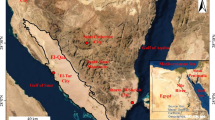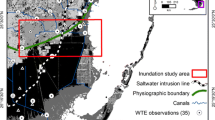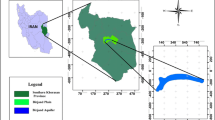Abstract
Uncertainty in hydrogeological modeling has recently received attention. It has been reported that the geological model is one of the primary sources of uncertainty. The present study developed a synthetic geological model (SGM) based on the geological characteristics in Taiwan as the baseline. Simulated geological models with various levels of data sufficiency were assessed based on multiple borehole numbers, with and without the incorporation of geological knowledge, and a combination of geophysical data with borehole data. The models were used in groundwater flow and land subsidence simulations. The results from the models were assessed and compared by calculating the root-mean-square error and coefficient of determination (R2) corresponding to SGM to evaluate the geological model uncertainty. The results show that a model based on data from 17 boreholes that incorporates geological knowledge for a 300 m × 300 m site provides an acceptable assessment of land subsidence. The geological model that incorporates geological knowledge extensively improves the numerical models, demonstrating that geological knowledge is necessary for deriving geological models. The model using geophysical data with correction based on data from at least 13 boreholes provided better results compared with those obtained using data from various numbers of boreholes or only geophysical data. This study demonstrates that additional data can significantly decrease the uncertainty in geological and numerical models. The results can be used by engineers and researchers to decide on a suitable strategy for engineering geology projects based on the precision requirements and budget. They can also help minimize risk when modelers and stakeholders make decisions.



















Similar content being viewed by others
References
Archie GE (1942) The electrical resistivity log as an aid in determining some reservoir characteristics. Transactions of the AIME 14601:54–62
Benedek K, Molnár P (2013) Combining structural and hydrogeological data: Conceptualization of a fracture system. Eng Geol 163:1–10
Boyd DL, Walton G, Trainor-Guitton W (2019) Quantifying spatial uncertainty in rock through geostatistical integration of borehole data and a geologist’s cross-section. Eng Geol 260:105246
Bredehoeft J (2005) The conceptualization model problem—surprise. Hydrogeol J 131:37–46
Bredehoeft JD (2003) From models to performance assessment: the conceptualization problem. Groundwater 415:571–577
Carrera J, Alcolea A, Medina A, Hidalgo J, Slooten LJ (2005) Inverse problem in hydrogeology. Hydrogeol J 131:206–222
Chiles J-P, Aug C, Guillen A, Lees T (2004) Modelling the geometry of geological units and its uncertainty in 3D from structural data: the potential-field method. Proceedings of international symposium on orebody modelling and strategic mine planning, Perth, Australia, Citeseer
De Loera J, Rambau J, Santos F (2010) Triangulations: structures for algorithms and applications. Berlin, Germany
Deng Z, Ke Y, Gong H, Li X, Li Z (2017) Land subsidence prediction in Beijing based on PS-InSAR technique and improved Grey-Markov model. Giscience Remote Sensing 54(6):797–818. https://doi.org/10.1080/15481603.2017.1331511
Doyoro YG, Chang P-Y, Puntu JM (2021) Uncertainty of the 2D resistivity survey on the subsurface cavities. J Appl Sci 11(7):3143
Fan Y, Huang GH, Baetz BW, Li Y, Huang K, Li Z, Chen X, Xiong L (2016) Parameter uncertainty and temporal dynamics of sensitivity for hydrologic models: A hybrid sequential data assimilation and probabilistic collocation method. Environ Model Softw 86:30–49
Fournier A, Fussell D, Carpenter L (1982) Computer rendering of stochastic models. Commun ACM 256:371–384
Gallagher M, Doherty J (2007) Parameter estimation and uncertainty analysis for a watershed model. Environ Model Softw 227:1000–1020
Gong W, Zhao C, Juang CH, Tang H, Wang H, Hu X (2020) Stratigraphic uncertainty modelling with random field approach. Computers Geotechnics 125:103681. https://doi.org/10.1016/j.compgeo.2020.103681
Guillaume JH, Qureshi ME, Jakeman AJ (2012) A structured analysis of uncertainty surrounding modeled impacts of groundwater-extraction rules. Hydrogeol J 205:915–932
Harbaugh AW, Banta ER, Hill MC, McDonald MG (2000) MODFLOW-2000, the U.S. geological survey modular ground-water model-user guide to modularization concepts and the ground-water flow process. Open-file report. U.S. Geological Survey 92:134.https://doi.org/10.3133/ofr200092
Hassan AE, Bekhit HM, Chapman JB (2008) Uncertainty assessment of a stochastic groundwater flow model using GLUE analysis. J Hydrol 3621–2:89–109
Hoffmann J, Leake SA, Galloway DL, Wilson AM (2003) MODFLOW-2000 ground-water model–User guide to the subsidence and aquifer-system compaction (SUB) package. Open-File Report u s Geological Survey 03:233
Højberg A, Refsgaard J (2005) Model uncertainty–parameter uncertainty versus conceptual models. Water Sci Technol 526:177–186
Hong QX (2011) Using MODFLOW associated with SUB package to predict vertical average of long-term land subsidence in Yunlin. National Central University, Taiwan
Jacob CE (1940) On the flow of water in an elastic artesian aquifer. EOS Trans Am Geophys Union 212:574–586
Johnson AI (1967) Specific yield: compilation of specific yields for various materials. D.C., United States, Washington
Juang CH, Zhang J, Shen M, Hu J (2019) Probabilistic methods for unified treatment of geotechnical and geological uncertainties in a geotechnical analysis. Eng Geol 249:148–161
Kanli AI, Neducz B (2015) Electromagnetic measurements for monitoring molybdenum contamination in near-surface survey. Earth Sci Res J 19(2):107–111
Leake S (1990) Interbed storage changes and compaction in models of regional groundwater flow. Water Resour Res 269:1939–1950. https://doi.org/10.1029/WR026i009p01939
Lelliott M, Cave M, Wealthall G (2009) A structured approach to the measurement of uncertainty in 3D geological models. Q J Eng Geol Hydrogeol 421:95–105. https://doi.org/10.1144/1470-9236/07-081
Lemon AM, Jones NL (2003) Building solid models from boreholes and user-defined cross-sections. Comput Geosci 295:547–555
Li Z, Wang X, Wang H, Liang RY (2016) Quantifying stratigraphic uncertainties by stochastic simulation techniques based on Markov random field. Eng Geol 201:106–122
Liu X, Wang Y, Yan S, Shao Y, Zhou H, Li Y (2019) Ground subsidence characteristics associated with urbanization in East China analyzed with a Sentinel-1A-based InSAR time series approach. Bull Eng Geol Env 786:4003–4015. https://doi.org/10.1007/s10064-018-1383-6
Loke MH, Acworth I, Dahlin T (2003) A comparison of smooth and blocky inversion methods in 2D electrical imaging surveys. Explor Geophys 34(3):182–187
Mahmoudpour M, Khamehchiyan M, Nikudel MR, Ghassemi MR (2016) Numerical simulation and prediction of regional land subsidence caused by groundwater exploitation in the southwest plain of Tehran. Iran Engineering Geology 201:6–28. https://doi.org/10.1016/j.enggeo.2015.12.004
Marinoni O (2003) Improving geological models using a combined ordinary–indicator kriging approach. Eng Geol 691–2:37–45
McDonald MG, Harbaugh AW (1988) A modular three-dimensional finite-difference ground-water flow model: U.S. Geological Survey Techniques of Water Resources Investigations
Meinzer OE (1928) Compressibility and elasticity of artesian aquifers. Econ Geol 233:263–291
Moradkhani H, Hsu KL, Gupta H, Sorooshian S (2005) Uncertainty assessment of hydrologic model states and parameters: Sequential data assimilation using the particle filter. Water Resour Res 415
Neuman SP (2003) Maximum likelihood Bayesian averaging of uncertain model predictions. Stoch Env Res Risk Assess 175:291–305
Nyári Z, Kanlı AI (2007) Imaging of buried 3D objects by using electrical profiling methods with GPR and 3D geoelectrical measurements. J Geophys Eng 4(1):83–93
Nyári Z, Kanlı AI, Stickel J, Tillmann A (2010) The use of non-conventional CPTe data in determination of 3-D electrical resistivity distribution. J Appl Geophys 70(3):255–265
Qi X-H, Li D-Q, Phoon K-K, Cao Z-J, Tang X-S (2016) Simulation of geologic uncertainty using coupled Markov chain. Eng Geol 207:129–140
Qi X-H, Liu H-X (2019) An improved global zonation method for geotechnical parameters. Eng Geol 248:185–196
Refsgaard JC, Christensen S, Sonnenborg TO, Seifert D, Højberg AL, Troldborg L (2012) Review of strategies for handling geological uncertainty in groundwater flow and transport modeling. Adv Water Resour 36:36–50
Refsgaard JC, Van der Sluijs JP, Brown J, Van der Keur P (2006) A framework for dealing with uncertainty due to model structure error. Adv Water Resour 2911:1586–1597
Rojas R, Feyen L, Dassargues A (2008) Conceptual model uncertainty in groundwater modeling: Combining generalized likelihood uncertainty estimation and Bayesian model averaging. Water Resour Res 4412
Rubin Y, Hubbard SS (2006) Hydrogeophysics. Berlin, Germany
Rushton KR, Redshaw SC (1979) Seepage and groundwater flow: Numerical analysis by analog and digital methods
Shi X, Fang R, Wu J, Xu H, Sun Y, Yu J (2012) Sustainable development and utilization of groundwater resources considering land subsidence in Suzhou, China. Eng Geol 124:77–89
Shi X, Wu J, Ye S, Zhang Y, Xue Y, Wei Z, Li Q, Yu J (2008) Regional land subsidence simulation in Su-xi-Chang area and Shanghai City, China. Eng Geol 1001–2:27–42
Tao Y, Sun H, Cai Y (2020) Predicting soil settlement with quantified uncertainties by using ensemble Kalman filtering. Eng Geol 276:105753
Terzaghi K (1925) Principles of Soil Mechanics Engineering News-Record 9519–27:19–32
Tildy P, Neducza B, Nagy P, Kanli AI, Hegymegi C (2017) Time lapse 3D geoelectric measurements for monitoring of in-situ remediation. J Appl Geophys 136:99–113
Tran D-H, Wang S-J, Nguyen QC (2022) Uncertainty of heterogeneous hydrogeological models in groundwater flow and land subsidence simulations—a case study in Huwei Town. Taiwan Engineering Geology 298:106543
Tsai VJ (1993) Delaunay triangulations in TIN creation: an overview and a linear-time algorithm. Int J Geogr Inf Sci 76:501–524
Vrugt JA, Diks CG, Gupta HV, Bouten W, Verstraten JM (2005) Improved treatment of uncertainty in hydrologic modeling: Combining the strengths of global optimization and data assimilation. Water Resour Res 411
Wang H, Wellmann JF, Li Z, Wang X, Liang RY (2017a) A segmentation approach for stochastic geological modeling using hidden Markov random fields. Math Geosci 492:145–177
Wang S-J, Lee C-H, Hsu K-C (2015) A technique for quantifying groundwater pumping and land subsidence using a nonlinear stochastic poroelastic model. Environmental Earth Sciences 7312:8111–8124. https://doi.org/10.1007/s12665-014-3970-6
Wang S-J, Lee C-H, Yeh C-F, Choo YF, Tseng H-W (2021) Evaluation of climate change impact on groundwater recharge in groundwater regions in Taiwan. Water 13(9):1153
Wang S-J, Hsu K-C (2009) The application of the first-order second-moment method to Analyze poroelastic problems in heterogeneous porous media. J Hydrol 369(1–2):209–221
Wang X, Wang H, Liang RY (2018) A method for slope stability analysis considering subsurface stratigraphic uncertainty. Landslides 155:925–936
Wang Y, Akeju OV, Zhao T (2017b) Interpolation of spatially varying but sparsely measured geo-data: a comparative study. Eng Geol 231:200–217
Yao Y, Zhang M, Deng Y, Dong Y, Wu X, Kuang X (2021) Evaluation of environmental engineering geology issues caused by rising groundwater levels in Xi'an, China. Eng Geol 106350
Yeh C-H, Dong J-J, Khonevisan S, Juang CH, Huang W-C, Lu Y-C (2021) The role of the geological uncertainty in a geotechnical design–A retrospective view of Freeway No. 3 Landslide in Northern Taiwan. Eng Geol 106233
Zhang Q-L, Chen Y-X, Jilani G, Shamsi IH, Yu Q-G (2010) Model AVSWAT apropos of simulating non-point source pollution in Taihu lake basin. J Hazard Mater 174(1–3):824–830
Zhao T, Xu L, Wang Y (2020) Fast non-parametric simulation of 2D multi-layer cone penetration test (CPT) data without pre-stratification using Markov Chain Monte Carlo simulation. Eng Geol 273:105670
Acknowledgements
The authors would like to thank Prof. Chang-Hsein Juang and Prof. Jia-Jyun Dong for providing valuable comments and suggestions to improve the quality of this study. This study was mainly funded by the Shackleton Program “Geological Uncertainty and Societal Risk: the Perspectives of Engineering, Environment, and Geohazards” of the Ministry of Science and Technology, Taiwan (MOST), under grant MOST 108-2638-E-008-001-MY2 and partly funded by MOST under grants MOST 106-2116-M-008-023-MY3 and MOST 110-2123-M-008-001 and the Water Resources Agency, Taiwan, under grants MOEAWRA 1100304 and MOEAWRA 1110346.
Author information
Authors and Affiliations
Contributions
Shih-Jung Wang: conceptualization, writing—review and editing, validation, discussion, supervision; Quoc Cuong Nguyen: data curation, methodology, software, writing—original draft, discussion; Yu-Chen Lu: methodology, original model creation; Yonatan Garkebo Doyoro: methodology; Duc-Huy Tran: discussion.
Corresponding author
Ethics declarations
Competing interests
The authors declare no competing interests.
Rights and permissions
About this article
Cite this article
Wang, SJ., Nguyen, Q.C., Lu, YC. et al. Evaluation of geological model uncertainty caused by data sufficiency using groundwater flow and land subsidence modeling as example. Bull Eng Geol Environ 81, 331 (2022). https://doi.org/10.1007/s10064-022-02832-7
Received:
Accepted:
Published:
DOI: https://doi.org/10.1007/s10064-022-02832-7




